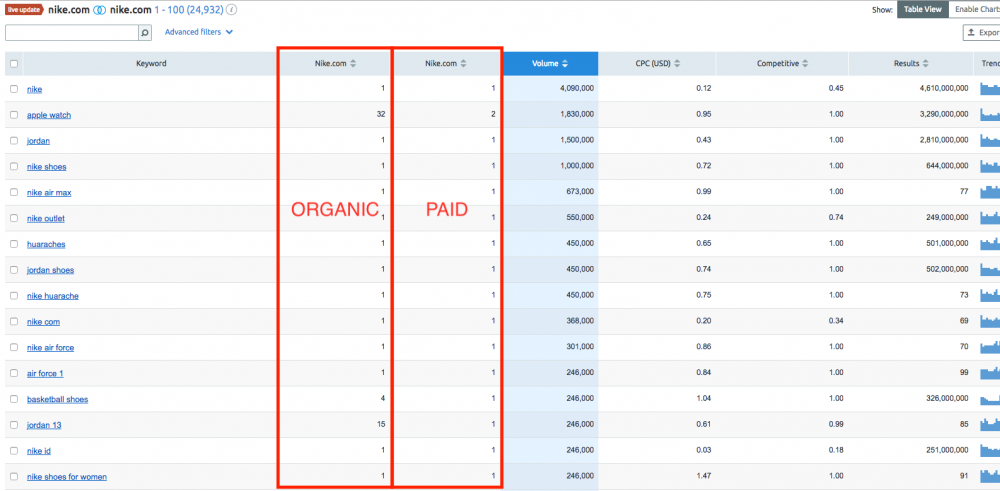Table of contents
Your competitors are speeding past you in the race for Google’s #1 organic position. How are they doing it?
You might feel like you’ll need to dig out your spy goggles to find the secret sauce they’re using to crack Google.
…But you don’t.
The only spy goggles you need come in the form of competitor analysis.
In this guide, we’ll talk about what competitor analysis is–and how you can spy on your competitors to up-level them in any area.
What is A Competitor Analysis?
Competitor analysis is doing background research on the businesses (or websites) you’re competing with.
For example, you might be an eCommerce company looking to see how you can beat your competitor and win their customers. Competitor analysis helps you do that: Spot where you can get ahead.
However, Jasz Joseph of SyncShow notes something you’ll need to remember when analyzing your competitors: “It is always important to look at your keyword competitors as well as your business competitors.”
“A company can not sell the same products/services as you and still be an SEO competitor.”
“For instance, if you sell shoes and want to rank for “best running shoes,” you can be competing with running bloggers. Yes, they are not competing with you for customers or business but they are competing on an SEO keyword front.”
Joseph adds: “Too many companies forget about these companies when conducting competitive analyses and it ends up hurting their overall performance in the long run.”
The importance of competitor analysis
Wondering why you need to do competitor analysis? Patricio Quiroz of Code Authority explains: “You should be running competitor analysis regularly to see how you can gain an advantage on search engines.”
“This will give you insights on what will work for your industry and what doesn’t.”
“You can also find your competitor’s weaknesses and capitalize on them. Alternatively, you can also pinpoint your competitor’s strengths and replicate them in your own SEO campaigns.”
“Finally, you can track your competitor’s organic keywords and popular content that you could possibly rank for,” Quiroz adds.
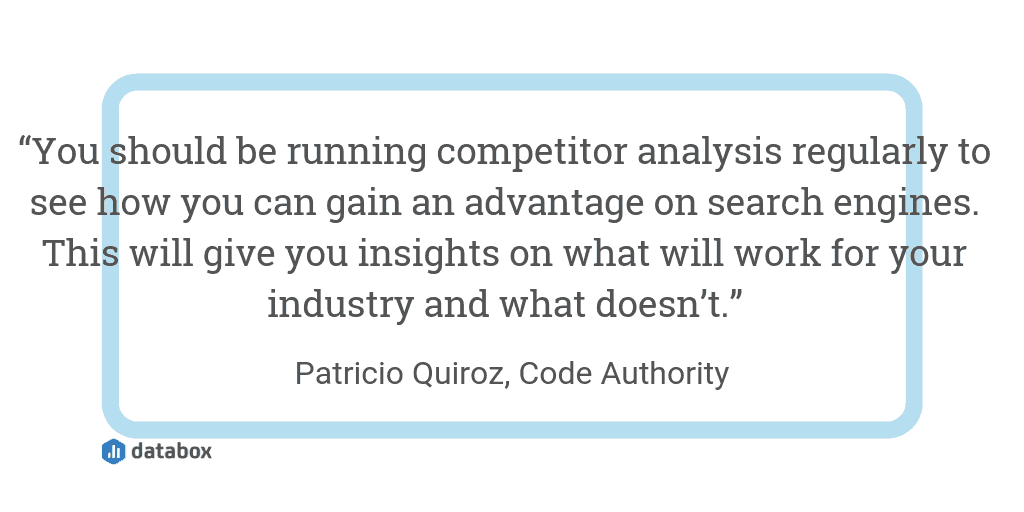
7 Competitor Analysis Tools (and how to use them)
Are you convinced to start taking a look behind the scenes of your competitor’s business (or website)?
We’ll share the best competitor analysis tools you can use, including:
1. Ahrefs
Ahrefs is the most popular competitor analysis tool, with over 40% saying they use the SEO tool to analyze their competitors:
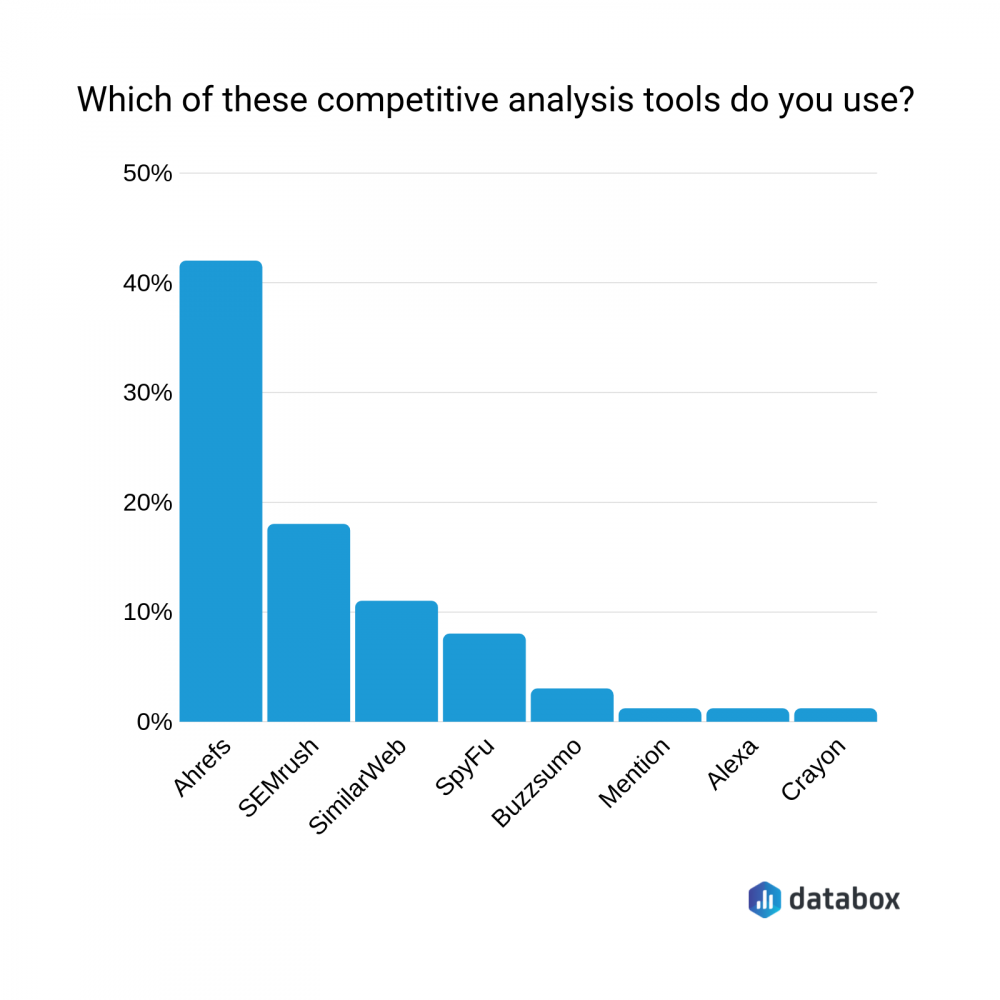
So, how do they use it? Here are two major use cases.
a) Look for new competitor links
Ted Chan of CareDash explains how their team uses these competitor analysis tools: “We identify places that list multiple competitors that are very effective for this are backlink overlap/intersect tools. We use SEMRush and Moz, and they both have this – I also know Ahrefs is.”
“Once we identify the list, we pitch to develop awareness or win a mention/link. Since we have multiple competitors and some lists or articles will omit some, it takes a bit of tinkering with the competitor sites to get to a list that’s both narrow and exhaustive enough to talk to.”
Matt Diggity of Diggity Marketing adds another hack: “Using Ahrefs, input your competitors’ root domain name and sort their backlinks by Domain Rating.”
“Pay close attention to freshly discovered links (Ahrefs crawls sites frequently and is very accurate, so it will be your best source of this information). If you see new links pop up from domains with a high rating, make sure that the content attracting those links is not a blind spot on your own website,” Diggity explains.
“Make sure that you’ve written adequately about the subject and then do outreach to see if you can win the link instead, or at minimum get a backlink as well.”
b) Find their top-ranking pages for content ideas
Josh Brown of Sumo Media LLC also adds that with Ahrefs “finding your competitors most trafficked (and profitable) content is easier than most realize.”
“Inside Ahrefs, insert your competitor’s domain name, click enter, and then browse to the “Top Pages” link on the left-hand navigation.”
“Inside the “Top Pages” section, you will instantly bear witness to pure gold: their most trafficked pages with all associated keywords sorted by monthly traffic value and volume.”
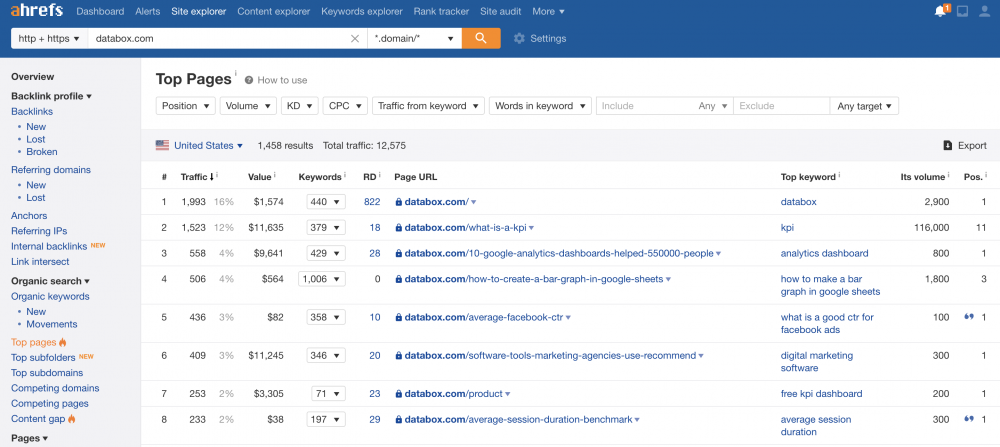
Brown continues: “Next, pick the “top keywords” of interest, and compose content around them for your own site, except do an even better job than they did.”
MyRoofingPal‘s Jesse Silkoff adds: “I have come up with countless ideas for valuable new pages on my own sites by using the “top pages” view on Ahrefs. The key is to look for pages on a competitor’s site that drives a lot of traffic, with high value, and a low amount of referring domains.”
Plus, Break The Web‘s Jason Berkowitz says: “With Ahrefs, locating opportunities in which your competitors are generating traffic, yet your site has no visibility is an absolute win. The Gap Analysis allows you to dissect their page and have a baseline focus for improving the content, information, or perceived value.”
You’ve collected tons of data about your competitors’ top-performing content. But what happens next–and how can you beat them?
Mio‘s Dominic Kent says: “When analyzing what works best for your competition if it’s relevant, make it bigger and better than they did.”
“If they are top of Google for a specific key phrase or search term, make that same piece of content – but do it 10x better. Creating long-form content of shorter snippets that your competition excels in will have you ranking above them in no time.”
2. SEMRush
“SEMrush has been a game-changer for [Weidert Group] with both their Keyword Gap Analysis and Backlink Gap Analysis tools,” says Frank Isca.
“Both reports allow you to benchmark your website against a handful of competitors at the same time, to quickly see side-by-side where there are similarities or gaps in the specific keywords each website is ranking for and where specific backlinks are coming from.”
Isca explains: “This can quickly provide insights into new keywords you haven’t considered utilizing or ones you should shy away from if they’re being overused by your competitors.”
“And the backlink insights can quickly help you compile a shortlist of new link building opportunities that your competitors have already sniffed out.”
Luke Wester also uses SEMRush tool at Miva “to look at your competitors’ keyword and backlink profiles. This will show you the gaps where your site needs to produce content in order to compete in the SERPs. This will also help you target the right sites when earning links.”
Plus, seobook‘s Aaron Wall adds: “Inside SEMrush there is a feature for historical data which allows you to look up the historical performance for websites that are currently penalized or offline. Their data goes back to early 2012, so it is pre-Penguin.”
3. Screaming Frog
Filip Silobod of Honest Marketing thinks that “using Screaming Frog on a competitor’s website especially for ecommerce and filtering them out by their product title. You will see their meta title, description, what does it lack so you can differentiate your message in the metadata.”
Roman Kim of The Sleep Judge adds: “Everyone is using XML Sitemaps to submit their URL to Google for quick and efficient indexing, with modified dates attached.”
“This standardized format also makes it super easy to identify new content coming out of any website for the purpose of monitoring competitor activity. You can either browse these sitemaps manually or have them crawled with automated tools like ScreamingFrog.”
Brian Jensen of Congruent Digital summarizes: “Run a crawler like Screaming Frog through a competitor’s website to get a feel for how they are optimizing their website.”
“More specifically, look at their H1, title tags, meta descriptions, the schema markup they are using and the types of content they are investing in.”
“This combined with other types of competitive analysis will help paint a more complete picture of your competitor’s strategy,” Jensen says.
4. SpyFu
“Our best tip to perform competitor analysis is to look at how prospects are finding them online,” writes Giselle Bardwell of Kiwi Creative.
“Our favorite tool for this is SpyFu, which allows us to get a look at their website, the keywords trailing back to their content, and their overall SEO growth.”
Bardwell explains: “What we find is that the overwhelming majority of prospective customers research businesses before reaching out; so piecing together data that allows you to get a holistic view of what those prospective customers will see when they research your company or your competitor is absolutely crucial to your business success.”
“We also recommend including “share of voice” or “digital mindshare” in your competitor research to further understand any weak points and start shifting momentum toward your brand.”
5. Google
“There are so many competitive tools out there that help you dive deeper into what your competitors are up to digitally, but my number one tip is to not underestimate the power of actually reviewing the SERPs for competitive queries,” writes Rachael Cecko of Lake One.
“Google is always coming up with ways to enhance the search experience for users (image packs, multimedia, etc.) and not all of them are documented by third-party tools.”
Cecko adds: “Are you showing up or is a competitor? Check things out in the wild.”
Darren Taylor of The Big Marketer also uses a Google product for competitor analysis–this time, Google Trends: “If you want to get an idea of competitor mentions, exposure and the intention of competitors, you can get an alert from Google.”
“When your competitors create new content, or if someone mentions their business you can analyze their mentions and see if you can capitalize on them too! They are really easy to set up and can open up SEO opportunities and content ideas.”
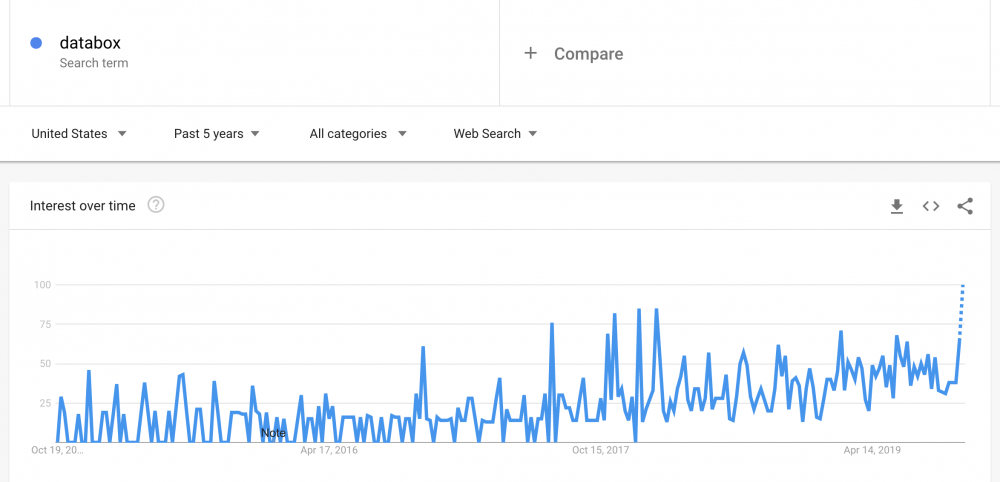
6. On-page competitor tools
You might be questioning whether there are any free tools you can use to analyze your competitors’ website.
Luckily, there are:
- Google PageSpeed Insights: Tarun Gehani says Pure Visibility use this tool “to see how the competition stacks up in terms of page loading speed, which can directly influence keyword rankings.”
- Wayback Machine: Andrew McLoughlin of Colibri Digital Marketing says: “It’s always useful to take a look at their mistakes and how they resolved them.” Tools like this let “you explore earlier versions of a competitor’s site to chart the changes and improvements they have made, to avoid making the same mistakes.”
7. A spreadsheet
Who says you need expensive software for competitor analysis?
“[YesCycling] has a nice spreadsheet file with our top 20 competitors, and we analyze them weekly for new blog posts, new backlinks, etc,” Alek Asaduryan explains.
“Normally we do it on UberSuggest or on Ahrefs if we have it paid for the month. Apart from that, we check weekly their websites for big design changes and new ideas which we can implement as well.”
Asaduryan continues: “We check the social networks as well just to be in touch with everything our competitors work on right now.”
OvalEdge‘s Sharad Warnshney adds: “With all the tools available on the market, it is too easy to get lost in the ocean of data that you can quickly collect while analyzing your competition.”
“You should better focus your efforts and get a very distilled and precise set of characteristics to look at by putting yourself in the shoes of your target audience, focusing on their pain points and solutions that can help them from the very beginning.”
“This approach will allow you to set an effective framework for your analysis, and you will end up comparing apples to apples and looking only at the tools that make the difference in this precise setup.”
*Editor’s note: Looking for a fancier version of a spreadsheet that’s easier to customize and share with your team? Check out our library of templates. We’re sure that you’ll find a tool you can pull your existing data from and present to your team:

15 Ways to Run An Competitive Analysis
1. Know your objective
Before we dive in with the tips you can use to analyze your competitors, Anne-Heloise Pagliardini of AHBC Group has one piece of advice: “Have an objective for the analysis.”
“This will enable you to then determine how broad you should go in your analysis (direct competitors only or larger competition). This will also enable you to look into the areas that most interest you.”
Pagliardini explains: “For example, is the objective for the competitive analysis is to determine the communications axis of each competitor in order to come up with positioning for a brand, we will look at their organic content, visuals, copy, etc.”
“If the objective is to check if our product / service pricing is right, we will look at the competition’s pricing. It seems like a no-brainer but it is sometimes overlooked, leading to broad analyses which are not very insightful.”
2. Find your value proposition
“Businesses sell the idea, and only then they sell the product,” writes Michael Sols.
“Ask a friend to choose between a Samsung or an iPhone. The ideas they could believe in here are that: one has better specs; one has a better design; one brand cares more about the customers; one is cheaper; etc.”
That’s why Sols would “advise CEOs to test their value proposition in a focus group research” by writing down “all value propositions that your business and its competitors offer. Start from the most crucial one that answers “Why would people use X”?
“Construct the survey so that you’ll have the answer to which business seems to offer the most with a reason behind it,” Sols continues.
“Look at the number of media publications a business has. The rule of thumb is that the more coverage is there, the more promising a market player is. This is a good avenue of exploration as journalists tend to discuss only the boldest of ideas.”
“If your competitor has more media features, maybe they offer substantially more to the market.”
James Pollard of The Advisor Coach agrees: “Figure out their unique value proposition. Once you figure out what makes your competitors unique, you can figure out a way to be different from that.”
‘If you can articulate your value and stand apart from everyone else, you will nullify your competition.”

3. Work with influencers to get insight on competitors
Carro‘s Sarah Donawerth recommends to “employ or partner with an influencer.”
“There are a lot of opportunities for brands to work with influencers, like ambassador programs, influencer marketing, and other partnerships. If you are working with influencers, you can see if they’ve had any great experiences with other brands that could inform your current strategy.”
4. Run a SWOT analysis
Mark Patchett of ecom academy says: “Without a doubt, my secret weapon is running a SWOT analysis looking at your reviews against your competitors.”
A SWOT analysis looks at these four pillars:
- Strengths
- Weaknesses
- Opportunities
- Threats
Patchett continues: “Identify the common themes across your reviews, e.g. is there something people are loving, are their standout benefits or features? Then run the same analysis across your competitive set.”
“Then run through all your ad messaging and theirs to assess how good a job you’re both doing at communicating key angles based on what your customers have said is most important to them.”
Patchett adds: “You’ll start to see some very clear areas that you can take advantage of and other areas you need to improve!”
SEO is the most popular area for competitor analysis, but you could apply Patchett’s advice to content marketing, social media, and paid search:
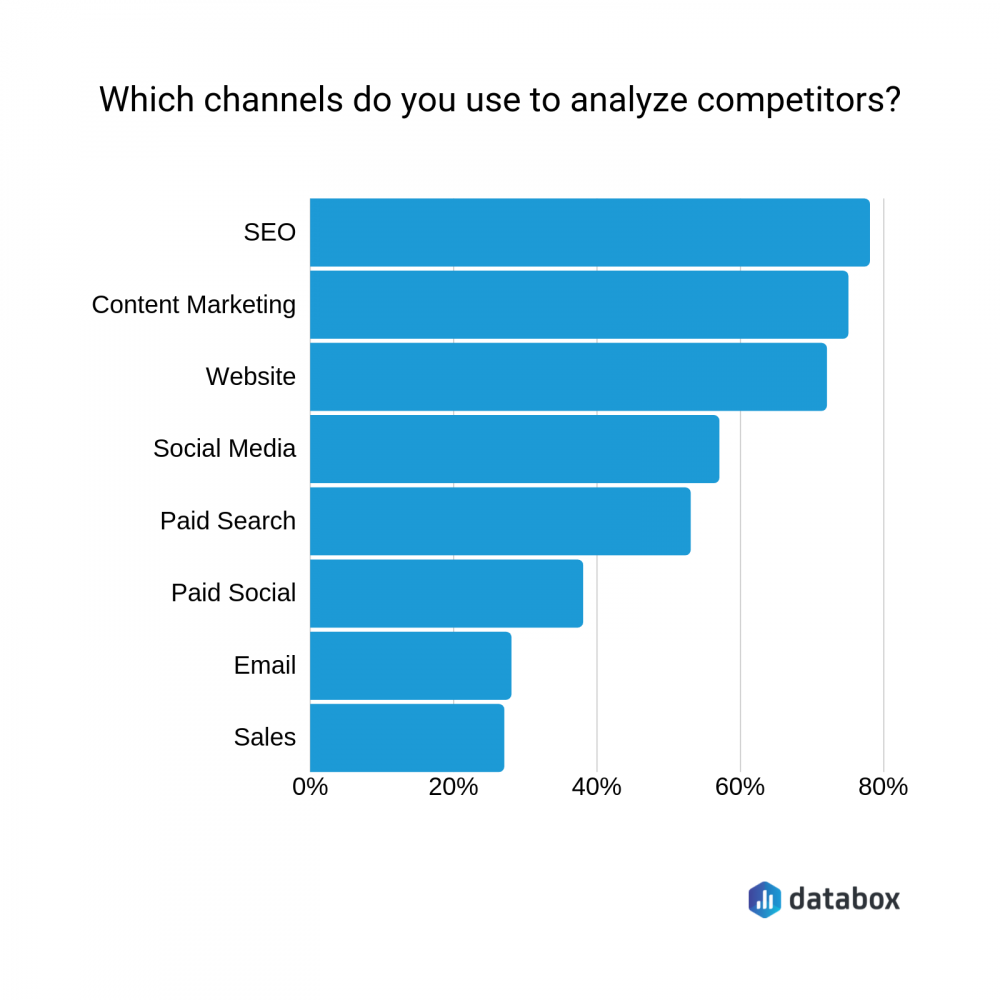
SyncShow‘s Cassie Simoniello agrees: “Be sure to include a keyword SWOT analysis. Analyzing your strengths, weaknesses, opportunities, and threats in comparison to your competitors can give you so much helpful information you may not have otherwise had.”
“This could include realizing certain topics that are untouched by competitors that you can easily rank for, or even give you ideas for creating new content based on keywords your competition is ranking for within the Google results pages.”
5. Analyze competitors’ on-page SEO
“Internet marketers usually focus on the kind of links their competitors are getting and they ignore the importance of on-page SEO,” Brandnic‘s Nadia Khan says.
“I would recommend marketers to perform comprehensive on-page SEO analysis to find the strengths and weaknesses of your competitors.”
“You can analyze the on-page factors of top-ranking sites in your niche and verify whether they have covered these factors or not. These factors include:
- Keyword in the title tag
- Keyword in the meta description
- Keyword in H1 tag”
Plus, Khan advises checking whether your competitors are “using keywords in pages copy, length of content, canonical tag, image optimization, updated content, outbound links, internal links and keyword in URL.”
“The way the website page is optimized has the most profound effect on its rankings over search engines like Google. If most of the sites from Page 1 of Google results haven’t covered these factors. There is a good chance you can outrank them,” Khan adds.
Hausera‘s Wesley Ward recommends asking: “What does their landing page include? Could the factors within their landing page be a reason why they’re ranking higher than you? What CTA’s are they using and how do they stand out?”
“These are questions to ask yourself when you’re going through their website,” Ward says.
6. Check competitor customer service
“Always include thorough customer service analysis in your competitive analysis to determine where your competitors are failing and succeeding when it comes to customer service,” My Trading Skills‘ Joe Bailey recommends.
“When choosing companies to analyze, always choose the ones that you are in direct competition with, and not necessarily the top 3-5 in the industry.”
Marta Ceccato of Sapiens Media Coaching shares how you can do this: “Read their customers reviews on Amazon, Google, Facebook etc. and pay attention to what users are saying about them, their services/products, prices, customer service, etc.”
Craig Streaman adds: “If you’re looking to take monthly subscribers away from competitors, capitalize on those who are already frustrated with their service. Use PPC to target keyword themes that identify customers looking to complain or leave the service.”
Streaman says that might be:
- “cancel (competitor name)”
- “unsubscribe (competitor name)”
- “(competitor name) customer service”
“With some clever ad copy, you can capture the eyes of in-market users that are already potentially paying for similar or related services,” Streaman summarizes.
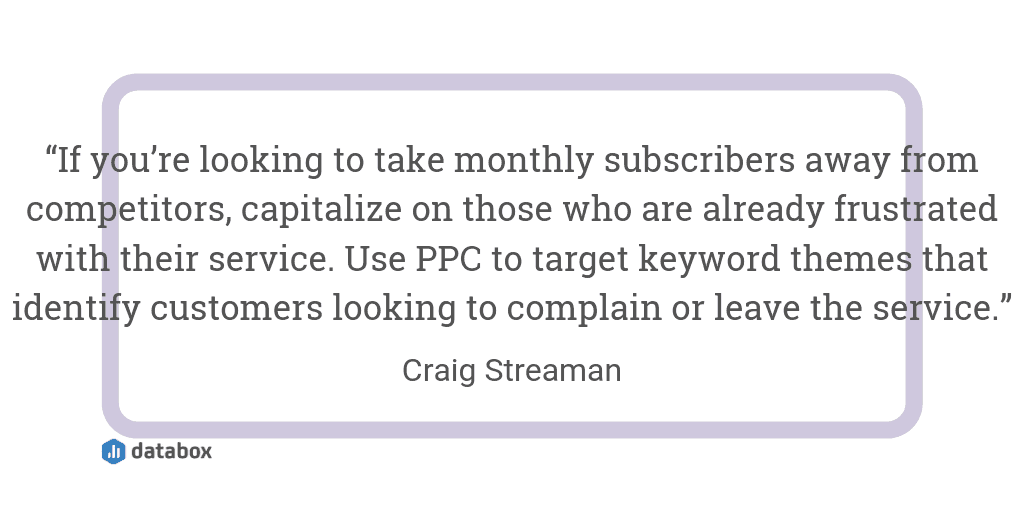
7. Sign up to your competitor’s mailing list
If you’re subscribed to a company’s mailing list, you feel like you’re taking a peek behind the scenes. It’s where they share unique, privileged information.
…Which is why SERP Wolf‘s Lana Volkov recommends “signing up to competitor’s email newsletters to gain more understanding of their strategy, which content they highlight and what keywords they are trying to target, can give you a lot of insight in terms of how to compete with their strategy.”
Farasat Khan also uses this tactic for IsItWP: “Opt-in for your competitor’s newsletter and signup as a lead to know their processes and mechanism for the customer journey.”
8. Analyze their backlink profile
Earlier, we touched on how you can use competitor analysis tools to find the backlinks pointing to your competitor’s website.
“Analyzing your competitor’s backlink profiles will take some time but they may reveal some priceless opportunities,” says Jacob Dayan of FinancePal.
“Like if you find that a competitor has robust content that’s gaining links quickly from prominent and authoritative sites they are most likely working with a PR company to promote their content which is an avenue you’ll need to explore to stay competitive.”
Matthew Woodward agrees: “Using SEO tools, such as Ahrefs and SEMrush, to analyze your competitors’ keywords and backlinks is a fantastic and fast way to get the information you need.”
“However you are still left with a huge amount of data to sort through… which is why I created 2 intelligent spreadsheets which take care of all the analysis for you in a matter of minutes.”
“You just need to enter in the data that you pull from the SEO tool and the spreadsheet will recommend which keywords you should optimize for or which are the best competitor backlinks you should be replicating.”
“So if you want to save a huge amount of time and develop an intelligent keyword/backlink strategy then you should use my FREE spreadsheets,” Woodward adds.
William Brown of Geek Powered Studios adds: “Many often ignore the links that are deemed ‘lost’ or ‘deleted’ and only look for the active links. My advice is to look into those ‘lost’ links and find out why those links are now gone.”
“Chances are the competitor might have had a permanent change in their URL or the page no longer exists, causing a 404 error for the webpage. It could be that the author deemed the link no longer relevant for their own content.”
Brown adds: “Find out the reason and perhaps you can pursue that link yourself (as long as you have the content relevant to the website.)”
*Editor’s note: Do you use Moz or AccuRanker? We have templates that can help you view your competitors’ backlinks–all in one place. It’s the best way to prevent missing a potential backlink opportunity:

9. Monitor their Facebook Ads
Zammo Digital‘s Aaron Zakowski thinks that “Facebook has made it very easy to spy on your competitor’s Facebook ads.”
“Check out Facebook’s Ad Library and search for your competitor’s business page. Then you can see all the active ads that they are currently running.”
Zakowski continues: “I usually like to scroll all the way to the bottom to see the ads that have been running the longest because those are most likely performing the best for them. It’s a good idea to check back frequently so you which tests your competition is running on an ongoing basis.”
In fact, PixelMe‘s Miriam Kung has a smart tool you can use for this: “Use AdInboxMe to get email alerts whenever a competitor launches a new Facebook Ad! It’s free and super useful to keep track of what competitors (or brands you like) are doing.”
10. Tune into to their brand mentions
Sandra Chung, who works for Mention, recommends to “use social listening to track your competitors’ media mentions, PR coverage, and campaigns.”
“Monitor which journalists, bloggers, and influencers they’re working with, and how. By doing so, you can put together a relevant media list based on the journalists that write about them and reach out to them. You can even track mentions of your competitors’ website URL with certain tools.”
The best part? You don’t need expensive software for this. You can track your competitor’s brand mentions using a tool we mentioned earlier: Google Trends.
11. Check their social media strategy
“You can obviously learn a lot by tracking the digital presence of your competitors and the brands you respect,” Mike Donnelly of Seventh Sense echoes.
“We automate this through two tools developed by Peakfeed which not only gives us insight into their social publishing but also things like how often, what time of day and day of the week they send emails.”
12. Analyze a competitor’s content cadence
Content cadence refers to the frequency of a competitor’s content marketing strategy.
MarketMuse‘s Stephen Jeske explains: “Understanding a competitor’s content cadence (how frequently and how much they publish) is critical to understanding what you’re up against.”
“One way to do this is through a site search on Google (site:URL) Click on the Tools button to select a date range so you can see how much content the competition has published during a specific time period.”
“Do this for your top 10 competitors and track it in a spreadsheet. Do this to determine whether you’re bringing a knife to a content marketing gunfight,” Jeske adds.
13. Check their recent job postings
SurgeStream‘s Kevin Williams recommends “checking job boards to see if your competitor is hiring or not and which jobs they are listing.”
“This can be a great indicator if they are planning something you are not aware of through normal channels and it can provide you great insight into their growth strategies.”
14. Take your competitor analysis offline
“As a sales company, our number one tip is that – it’s not all about the internet,” writes Tacuna Systems‘ Joseph Flanagan.
“Online analysis is the best way to understand your competitors. However, it’s not the only way. Try to analyze your competitors physically.”
Flanagan shares the technique they use to do this: “Order their products, study their delivery times and methods, visit their headquarters, understand their company culture. These will reveal a lot of things in the direction in which they are going.”
15. Don’t stop comparing
“Competitive analysis is not a one-and-done process,” says Crayon‘s Ellie Mirman. “Your competitors are constantly changing, just as you are.”
“So create a cadence that makes competitive analysis part of your day-to-day – it makes it easier to stay on top of competitive moves and makes your analysis much more timely and actionable.”
The majority of our experts agree, with almost half saying they conduct competitor analysis monthly:
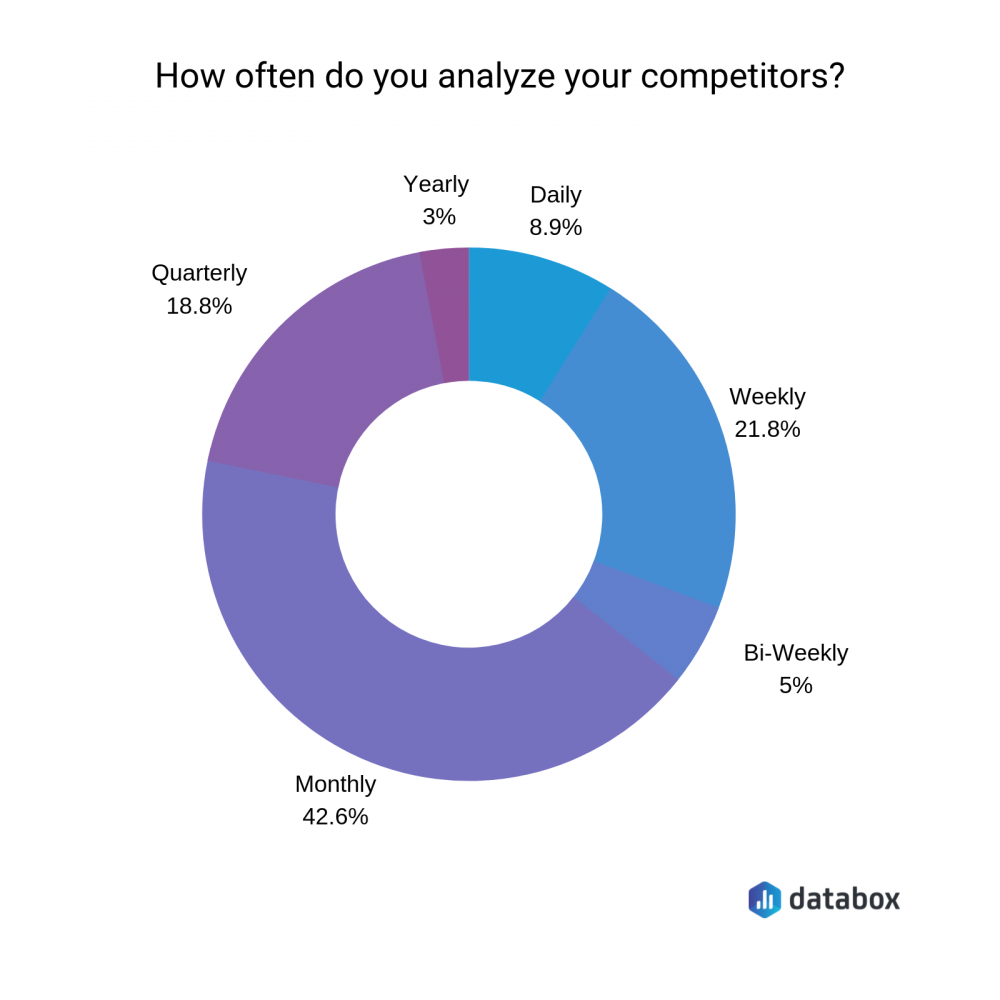
Ready to put your competitor data into action?
The tips we’ve shared here are bound to help you level-up your competitors.
But as G2‘s Lauren Pope summarizes: “The most overlooked tip for competitive analysis is to take everything with a grain of salt.”
“You can crawl their website, stalk their social media, and do competitive analysis all you want but at the end of the day, not everything your competitor does will work for your business.”
“Steal from the best and make it your own. Tweak everything, tailor it to your business model and your audience. A complete carbon copy of what is working for your competitors will not translate correctly when applied to a totally different model,” Pope writes.





